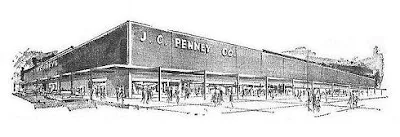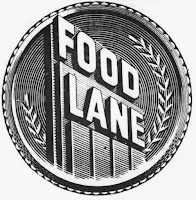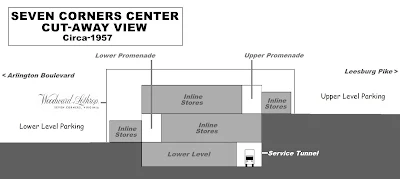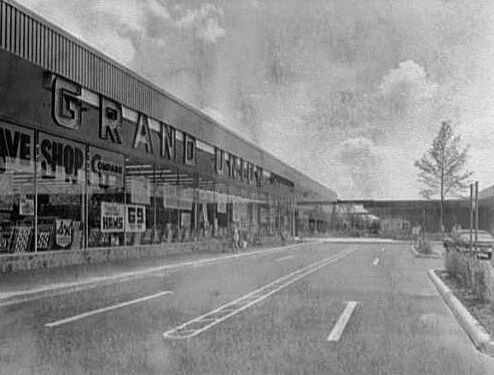SEVEN CORNERS CENTER
Arlington Boulevard / US 50 and Leesburg Pike
Fairfax County, Virginia
Construction commenced on Washington, DC's first suburban shopping mall in June 1955. The complex was built on a 32-acre tract, located 6 miles southwest of the United States Capitol, in an unincorporated section of Fairfax County, Virginia known as Seven Corners. The parcel was once occupied by the farm of Frederick Foote, Senior.
The area was named for its junction of five roads; Arlington Boulevard, Leesburg Pike, Wilson Boulevard, Sleepy Hollow Road and Hillwood Avenue. These merged at a point northwest of the shopping center tract and form "
Seven Corners."
SEVEN CORNERS CENTER was designed and developed by the DC-based Kass-Berger Organization. The first three operational tenants held grand openings on September 20, 1956. These stores were Joseph R. Harris, Franklin Simon and a 4-level (128,000 square foot) Woodward & Lothrop ["Low-thrup"]. The second anchor department store, a 3-level (71,000 square foot) Julius Garfinckel & Company, was dedicated, along with the rest of the mall, on October 4, 1956.
Open-air in format, the split-level shopping hub encompassed 600,000 leasable square feet and consisted of two covered concourses; one accessed from the southern (upper level) parking area, the second from the northern (lower level) lot. Beneath lower level stores was a basement, which connected with two service tunnels.
Charter inline stores included L. Frank Company, Peck & Peck, Chandler's Shoes and Mayer & Company Furniture. An F.W. Woolworth 5 & 10 and Peoples Drug had 2 levels. Woolworth's had an escalator between its floors; the levels of Peoples Drug were connected via a staircase. A Western Auto store and Fairfax County National Bank main office were outparcels of the mall proper.
In addition, there was a freestanding Food Lane supermarket. Operated as a subsidiary of Philadelphia-based Food Fair, the (32,000 square foot) grocery opened on November 28, 1956 and was rebranded as a Food Fair on September 15, 1960.
SEVEN CORNERS CENTER was the preeminent shopping destination in northern Virginia until the malling of the area gained impetus in the 1960s. Alexandria's LANDMARK CENTER {4 miles southeast, in Alexandria} was dedicated in 1965. TYSONS CORNER CENTER {5 miles northwest, in Fairfax County} opened in 1968.
Great Britain's Westminster Investing Corporation had acquired the SEVEN CORNERS complex in 1963. They performed an enclosing renovation between 1971 and 1972. At this time, they also proposed a major expansion that would have extended the mall onto an adjacent 11.6-acre parcel. Before the expansion could begin, the zoning of the land had to be changed from residential to commercial. Arlington County refused to approve the zoning change in September 1972. The expansion project was eventually abandoned.
Another more modest mall renovation was conducted in 1977. To make SEVEN CORNERS CENTER more competitive, it was deemed necessary to attract a younger clientele. Interior spaces were spruced up with new carpeting and fixtures. Sixteen new stores were also signed. These included Susie's Casuals, Pants Corral, Tiffany's Bakery, The Orange Bowl and Naturally Yogurt.
As the face lift renovation was being carried out, the malling of Washington and its environs continued unabated. By 1988, there were twenty regional shopping venues in the SEVEN CORNERS trade area. The days of SEVEN CORNERS CENTER as a major shopping center were coming to an end. This was exacerbated by the closing of its Garfinckel's, in June 1990. The building was leased to F & M Distributors, a discount drug store.
A prospective demalling of the property had been on the drawing board for some years. Phase I of the project got underway in the mid-1990s, under the auspices of Maryland-based Saul Centers. Smaller inline tenants were moved to an adjacent strip center in June 1995. The existing mall, excluding the Woodward & Lothrop structure, was gutted and reconfigured with exterior-entranced store spaces.
Woodward & Lothrop shut down in November 1995. Its building was demolished in October 1996. By this time, new Phase I stores had opened. These included Barnes & Noble, Ross Dress For Less, Best Buy and Bob's Store (a Connecticut-based discount apparel retailer). Two outparcel restaurants, Wendy's and Pizzaria Uno, opened for business in March and September 1996.
Phase II of the renovation involved the construction of a vertically-stacked (72,300 square foot) Shopper's Club Food & Pharmacy and (124,400 square foot) Home Depot. These were built on the old Woodward & Lothrop spot and opened for business in late 1997. A multilevel parking garage had also been constructed. With the dedication of these structures, the renewed SEVEN CORNERS CENTER encompassed approximately 561,000 leasable square feet and contained around thirty stores and services.
Over the ensuing years, tenants came and went. Bob's Store closed in the summer of 1997. Best Buy shut down in 2003. New Jersey's Syms apparel was in operation between August 2009 and December 2011. The Texas-based RoomStore, a home furnishings retailer, was shuttered in July 2012.
A (47,400 square foot) Burlington Coat Factory assumed space vacated by Syms, and opened its doors on October 26, 2012. Home Depot expanded into a 55,000 square foot space, which had been occupied by The RoomStore (and later by RoomStyle). The expanded (180,400 square foot) Home Depot was dedicated in September 2016.
Sources:
The Washington Post
The Evening Star (Washington, DC)
The Falls Church News-Free Press
The Northern Virginia Sun (Arlington, Virginia)
"Dual Anchor Shopping Centers 1952-1965" / Richard Longstreth
http://www.saulcenters.com (website on Internet Archive Wayback Machine)
http://www.saulcenters.com / Saul Centers
http://www.fccc.org / Fairfax County Chamber Of Commerce website






















































